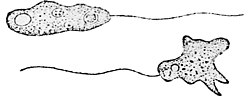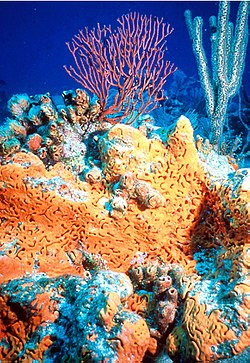The apusomonads (family Apusomonadidae) are a group of protozoan zooflagellates that glide on surfaces, and mostly consume prokaryotes. They are of particular...
16 KB (1,314 words) - 22:32, 9 May 2025
and fungi emerged. The relationships among opisthokonts, breviates and apusomonads are not conclusively resolved (as of 2018), though Breviatea is usually...
7 KB (527 words) - 02:59, 5 May 2025
implications. The term "Amastigomonas-like" is used to refer to all apusomonads that lack the 'derived' characteristics of Apusomonas. Organisms under...
6 KB (429 words) - 14:27, 20 May 2025
scientists later rejected. It includes amoebozoa, opisthokonts, and apusomonads. Thomas Cavalier-Smith proposed two new phyla: Sulcozoa, which consists...
9 KB (1,160 words) - 04:44, 26 May 2025
(2007). "The flagellar apparatus structure of Apusomonas proboscidea and apusomonad relationships". Protistology. 5 (2–3): 146–155. Cavalier-Smith T, Chao...
2 KB (118 words) - 14:28, 20 May 2025
was low, and they thus developed anaerobic lifestyles. Together with Apusomonads, they are the closest relatives of the Opisthokonts, a group that includes...
10 KB (827 words) - 22:30, 25 May 2025
kukwesjijk [de]/Hemimastix/Spironematellidae) are their own supra-kingdom. The apusomonads have two flagella inserted at right angles, near the anterior of the...
9 KB (1,033 words) - 21:17, 11 December 2024
parabasalids with proboscis (trunk-like protrusion of the cell): e.g., apusomonads, some bodonids According to the number of flagella, cells may be: (remembering...
66 KB (7,271 words) - 05:32, 25 May 2025
called Apusozoa made up of 3 protist groups breviata, ancyromonads and apusomonads. 37 (?) Amoebozoans (Amoebozoa) 'Amoeba' is a description rather than...
55 KB (1,068 words) - 04:12, 20 May 2025
Podomonas is a genus of apusomonads, a group of small zooflagellates that glide on their posterior cilium. The genus was identified in 2010 as an independent...
4 KB (360 words) - 13:56, 28 May 2025
demonstrates that breviate flagellates are related to opisthokonts and apusomonads". Proceedings of the Royal Society B: Biological Sciences. 280 (1769):...
51 KB (4,923 words) - 10:13, 25 May 2025
within the high level group Amorphea. Members of this family, known as apusomonads, are gliding heterotrophic protozoan zooflagellates that primarily feed...
7 KB (644 words) - 02:49, 27 May 2025
multicellularity. Nucleariids are unique within their greater evolutionary context. Apusomonads (relatives of opisthokonts), holozoans and fungi all evolved from ancestors...
31 KB (2,905 words) - 11:09, 25 May 2025
demonstrates that breviate flagellates are related to opisthokonts and apusomonads". Proceedings of the Royal Society B: Biological Sciences. 280 (1769):...
216 KB (23,075 words) - 08:14, 31 May 2025
proposed clade containing the Amorphea (incl. Opisthokonta, Amoebozoa, apusomonads and breviates) and the organisms now assigned to the clade CRuMs. Ancyromonadida...
5 KB (422 words) - 02:59, 5 May 2025
of heterotrophic protists. It is a monophyletic group, or clade, of apusomonads, a group of protozoa with two flagella closely related to the eukaryotic...
6 KB (517 words) - 00:06, 23 May 2024
fungi and related protists). They're related to the breviates and the apusomonads, and together form the clade Obazoa. CRuMs, (ranked as a phylum) composed...
9 KB (758 words) - 11:09, 19 May 2025
in, or near, an assortment of other groups, including the alveolates, apusomonads, ancyromonads, and Rhizaria. In an article published in 2018, Lax et...
9 KB (706 words) - 19:46, 26 February 2025
demonstrates that breviate flagellates are related to opisthokonts and apusomonads". Proceedings of the Royal Society B: Biological Sciences. 280 (1769)...
2 KB (200 words) - 21:41, 4 December 2024
Alastair G. B. (2015). "Cultivation and Characterisation of New Species of Apusomonads (the Sister Group to Opisthokonts), Including Close Relatives of Thecamonas...
3 KB (222 words) - 02:58, 8 April 2024
phylum Opalozoa, along with other unrelated groups of flagellates such as apusomonads, jakobids, cercomonads, spongomonads, katablepharids, ebriids, proteomyxids...
23 KB (2,105 words) - 21:01, 31 May 2025
"Molecular phylogeny of Unikonts: new insightsinto the position of apusomonads and ancyromonads and the internalrelationships of opisthokonts". Protist...
15 KB (1,600 words) - 22:17, 26 April 2025
"Molecular phylogeny of unikonts: new insights into the position of apusomonads and ancyromonads and the internal relationships of opisthokonts". Protist...
5 KB (1,167 words) - 11:40, 9 May 2025
demonstrates that breviate flagellates are related to opisthokonts and apusomonads". Proceedings of the Royal Society B: Biological Sciences. 280 (1769):...
4 KB (367 words) - 14:28, 20 May 2025















